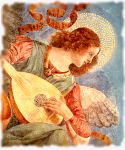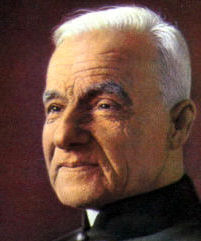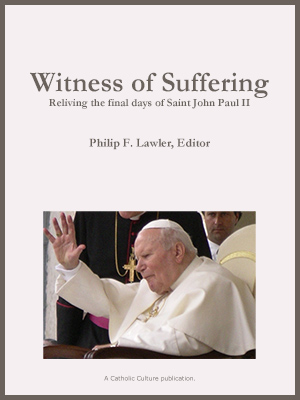Christmas: January 6th
Saturday of Christmas Time; Opt Mem of St. André Bessette, Religious (USA); Epiphany (traditional)
Other Commemorations: St. Andrew Corsini, Bishop (RM) ; Other Titles: In some places, Epiphany of Our Lord
» Enjoy our Liturgical Seasons series of e-books!
In the United States, today is the Optional Memorial of St. André Bessette, Religious (1845-1937). St. André was born near Quebec, and entered the Congregation of the Holy Cross as a Brother. He performed humble tasks for over forty years and entrusted all of the poor and sick who flocked to his cell to the care of St. Joseph. During his life he was able to have a chapel built to the spouse of the Virgin Mary. After his death, the shrine grew into the great basilica known as St. Joseph's Oratory in Montreal.
In various regions today is the Solemnity of the Epiphany of Our Lord. In the United States and other regions where the solemnity of the Epiphany is not observed as a holy day of obligation, it is assigned to a Sunday, which is then considered a proper day on the calendar, falling on the Sunday between 2 January and 8 January (from General Norms for the Liturgical Year and the Calendar).
The evening begins the Vigil of the Epiphany, which has a particular liturgy. The Vigil Mass is used on the evening of the day before the Solemnity, either before or after First Vespers (Evening Prayer I) of the Epiphany.
According to the Canadian Conference of Catholic Bishops (CCCB) calendar, the Optional Memorial of St André Bessette is celebrated in Canada on January 7.
The Roman Martyrology also commemorates St. Andrew Corsini (1302-1374), Bishop. He was born in the fourteenth century in Florence, Italy. He fell into bad company; but soon, touched by the grief of his mother, the young nobleman entered the Carmelite Order. Having served as prior of his convent, he was chosen to fill the vacant bishopric of Fiesole. He continually helped the poor, doing so in secret in the case of those who were ashamed to make known their distress. By showing his people the true nature of Christian peace, Bishop Andrew put an end to a number of troublesome disturbances in the city. He died on January 6, 1373.
St. André Bessette—Day Thirteen Brother André spent most of his days in a narrow lodge, with only a table, some chairs and a bench as furnishings. He was attentive to the needs of all, smiling, obliging. In the evening he would engage in the difficult work of maintaining the parlor and hallway floors. He was on his knees until late at night, washing, polishing, and waxing by the dim light of a candle.
Brother André spent most of his days in a narrow lodge, with only a table, some chairs and a bench as furnishings. He was attentive to the needs of all, smiling, obliging. In the evening he would engage in the difficult work of maintaining the parlor and hallway floors. He was on his knees until late at night, washing, polishing, and waxing by the dim light of a candle.
—Abbey of Saint-Joseph de Clairval
The use of candles is one of the loveliest Christmas customs that we can keep on using throughout the year. Now, more than ever, Christmas is a festival of light in a dark world, a time to hold our candles high, and to teach our children all the little ceremonies which make life gracious and full of meaning. No matter how long we live, nor how learned we become, we may travel the world over, and find nothing more beautiful than candlelight on the face of a child. "Now the Lord be thanked because we have light."
—Dorothy Albaugh Stickell
- Day Thirteen Activity (Candles for the Domestic Church)
- Day Thirteen Recipe (Yule Spice Cake)
St. André Bessette
Brother André expressed a saint's faith by a lifelong devotion to Saint Joseph.
Sickness and weakness dogged André from birth. He was the eighth of twelve children born to a French Canadian couple near Montreal. Adopted at twelve, when both parents had died, he became a farmhand. Various trades followed: shoemaker, baker, blacksmith—all failures. He was a factory worker in the United States during the boom times of the Civil War.
At twenty-five, he applied for entrance into the Congregation of the Holy Cross. After a year's novitiate, he was not admitted because of his weak health. But with an extension and the urging of Bishop Bourget (see Marie-Rose Durocher, October 6), he was finally received. He was given the humble job of doorkeeper at Notre Dame College in Montreal, with additional duties as sacristan, laundry worker and messenger. "When I joined this community, the superiors showed me the door, and I remained forty years."
 In his little room near the door, he spent much of the night on his knees. On his windowsill, facing Mount Royal, was a small statue of Saint Joseph, to whom he had been devoted since childhood. When asked about it he said, "Some day, Saint Joseph is going to be honored in a very special way on Mount Royal!"
In his little room near the door, he spent much of the night on his knees. On his windowsill, facing Mount Royal, was a small statue of Saint Joseph, to whom he had been devoted since childhood. When asked about it he said, "Some day, Saint Joseph is going to be honored in a very special way on Mount Royal!"
When he heard someone was ill, he visited to bring cheer and to pray with the sick person. He would rub the sick person lightly with oil taken from a lamp burning in the college chapel. Word of healing powers began to spread.
When an epidemic broke out at a nearby college, André volunteered to nurse. Not one person died. The trickle of sick people to his door became a flood. His superiors were uneasy; diocesan authorities were suspicious; doctors called him a quack. "I do not cure," he said again and again. "Saint Joseph cures." In the end he needed four secretaries to handle the eighty thousand letters he received each year.
For many years the Holy Cross authorities had tried to buy land on Mount Royal. Brother André and others climbed the steep hill and planted medals of Saint Joseph. Suddenly, the owners yielded. André collected two hundred dollars to build a small chapel and began receiving visitors there—smiling through long hours of listening, applying Saint Joseph's oil. Some were cured, some not. The pile of crutches, canes and braces grew.
The chapel also grew. By 1931 there were gleaming walls, but money ran out. "Put a statue of Saint Joseph in the middle. If he wants a roof over his head, he'll get it." The magnificent Oratory on Mount Royal took fifty years to build. The sickly boy who could not hold a job died at ninety.
He is buried at the Oratory and was beatified in 1982. On December 19, 2009, Pope Benedict XVI promulgated a decree recognizing a second miracle at Brother André’s intercession and on October 17, 2010, Pope Benedict XVI formally declared sainthood for Brother André.
—Saint of the Day, Leonard Foley, O.F.M.
Patronage: family caregivers in Canada
Highlights and Things to Do:
- Read more about St. André:
- Learn more about the Holy Cross Brothers, the order of which St. André was a member. Pray for an increase in vocations and for those who are already living the religious life.
- If you live close to St. Joseph's Oratory of Mount Royal, make a pilgrimage. If that's not possible make a virtual pilgrimage.
- Say a prayer for the sick who were so dear to the heart of Brother André.
- Sample authentic French Canadian food by trying the suggested Recipes.
- The remains of Brother André lie in the church he helped build, St. Joseph's Oratory. His body lies in a tomb built below the Oratory's Main Chapel, except for his heart, which is preserved in a reliquary in the same Oratory. The heart was stolen in March 1973, but was recovered in December 1974.
- See Catholic Cuisine for a maple candy recipe for this day.
St. Andrew Corsini
St. Andrew Corsini lived from 1302 to 1373. While still carrying him in her womb, his mother dreamed she had given birth to a wolf that sauntered to the gate of the Carmelite monastery, and entering the vestibule of the church, was changed to a lamb. Andrew was reared as a pious and God-fearing youth, but little by little he succumbed to the pleasures of the world in spite of frequent warnings and reproofs from his mother. After he became aware that his parents had vowed him to the service of Blessed Mary, he mended his ways and at the age of seventeen entered the Carmelite Order. Though persistently tempted and assailed by the devil, he never swerved from his holy decision. A man of austere penance, he fasted continuously, always wore a hair shirt, and prayed the penitential psalms daily. For humility's sake he often washed the feet of the poor and beggars. His special gift from God was the grace to effect the conversion of hardened sinners. In 1360, despite his efforts to the contrary, he was made bishop of Fiesole in Tuscany.
—Excerpted from The Church's Year of Grace, Pius Parsch
Patronage: Against civil disorder; against riots; Florence; Fiesole; Diplomats
Symbols and Representation: Holding a cross, with a wolf and lamb at his feet, and floating above a battlefield on a cloud or a white palfrey; Mitre; Episcopal attire; Carmelite habit
Highlights and Things to Do:
- Read more about St. Andrew Corsini:
- See the statue of St. Andrew in St. Peter's Basilica Colonnade.
- Pray to St. Andrew Corsini that your children, especially teenagers, may find their true vocation and follow it faithfully.
- St. Andrew's fellow Italians often sought his aid in solving the disputes which had split their families and cities — imitate this peacemaker, renowned for his prudence and wisdom, by sowing peace in your own home.






